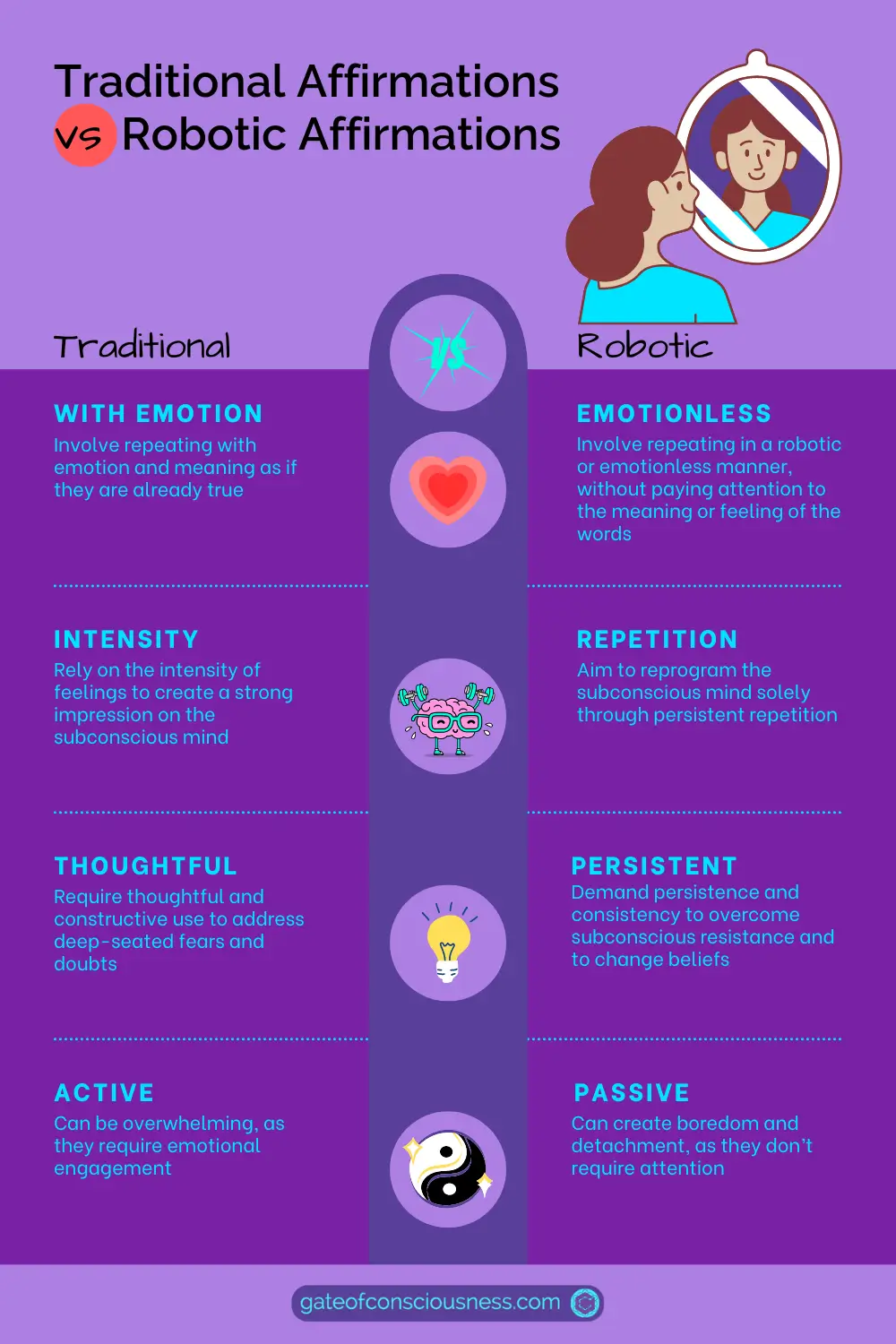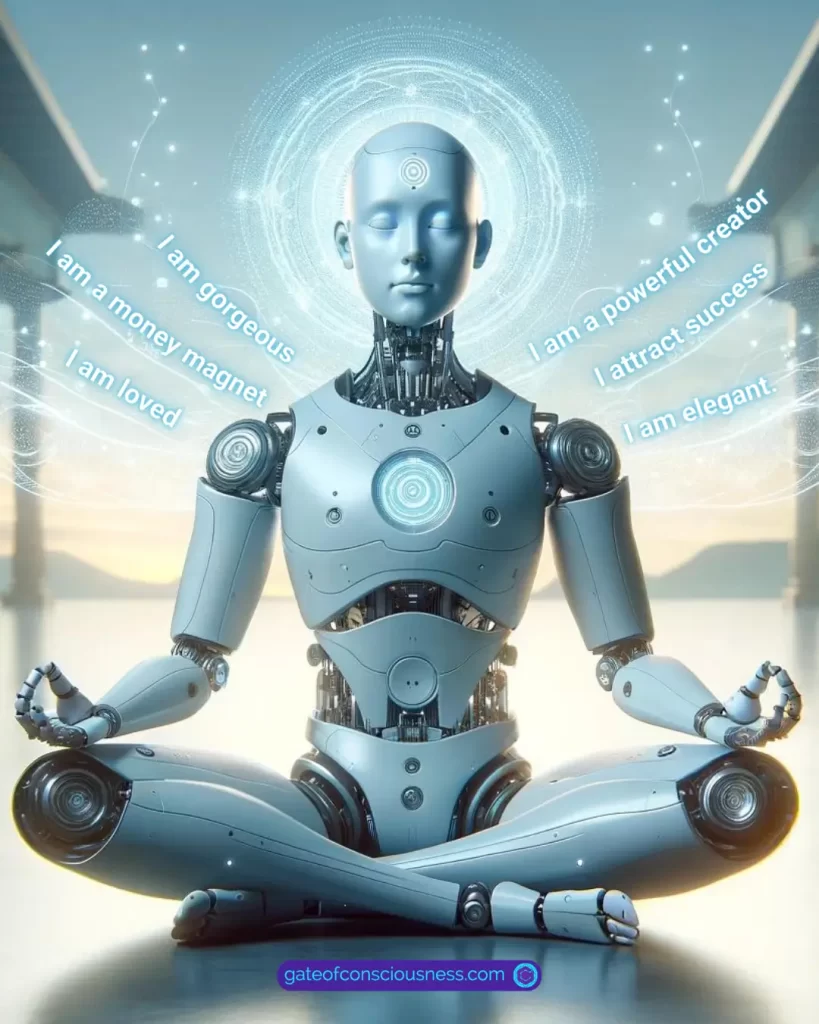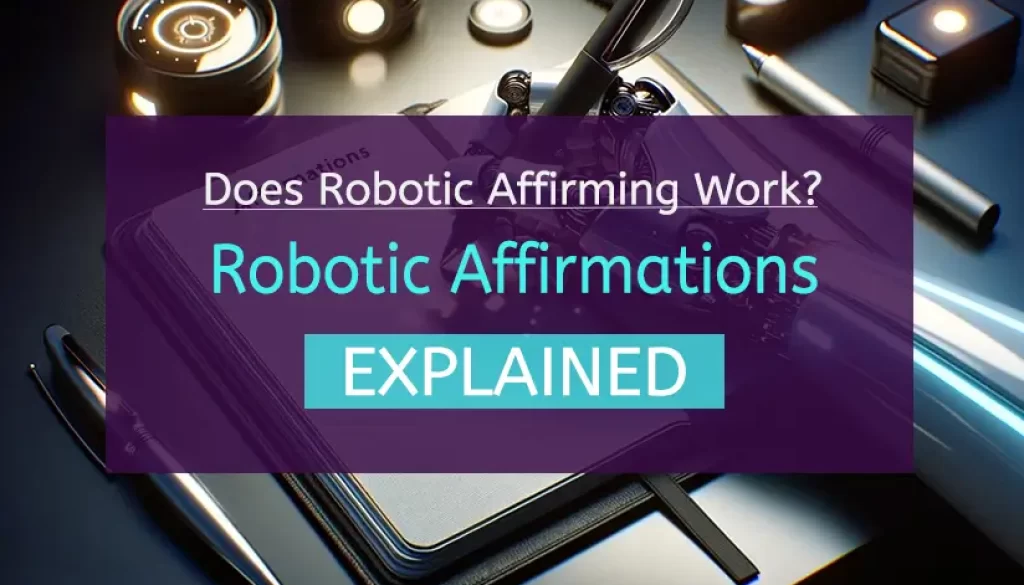Does Robotic Affirming Work? Robotic Affirmations Explained
Today’s topic is robotic affirming. We’ll finally answer the question that’s been stirring up curiosity: does it work? As a manifestation coach, I’ve had my fair share of experiences with affirmations, and let me tell you, the way we approach them makes all the difference. So, in this blog post, I’ll share my insights and opinions on robotic affirmations. We’ll explore what they are, how they work, and whether they truly can change our lives.
Table of Contents:
What Is Robotic Affirming?
Robotic affirming is a manifesting technique that works by repeating positive affirmations like a robot, hence the name.
Basically, you pick a phrase that implies that your desire is already true.
And then, you repeat it without paying attention to the meaning or feeling of the words.
Crazy, I know.
I remember back when I first heard about robotic affirming, I was extremely skeptical.
I mean, repeating robotic statements over and over again?
It sounded a bit, well, robotic.
But as I delved deeper into this topic, I began to understand how they can still impact our subconscious mind.
Traditional vs Robotic Affirmations: What’s the Difference?
The main difference lies in the feeling. Traditional affirmations are repeated with emotion. They rely on the intensity of feelings to create a strong impression on the subconscious mind. Robotic affirmations are repeated in a robotic or emotionless manner.

Infographic: Traditional vs. Robotic Affirmations
Do Robotic Affirmations Work?
Yes, robotic affirming can work because consistent repetition still impresses the subconscious mind.
It’s not necessary to feel the emotions associated with them, like with traditional affirmations.
With robotic affirmations, we’re reciting our affirmation and persisting in our practice until the subconscious is fully convinced.
The subconscious is the part of your mind that stores thoughts and beliefs you’re unaware of.
It also influences your behavior and habits.
The idea is to bypass the conscious mind and implant the affirmations into the subconscious.
Pros and Cons of Robotic Affirming
| Pros | Cons |
|---|---|
| It can overcome limiting beliefs that may be deeply ingrained in your subconscious. | Practicing affirmations this way may feel boring. |
| You can use it to avoid overthinking or analyzing your desires. | You miss the signs or opportunities that the universe may send you. |
| It can help you to avoid emotional attachment or desperation. | It can make you ignore feelings you shouldn’t. |
| You can practice it while doing other tasks. | It may take longer to see results. |
How to Use Robotic Affirming?
So, how do you practice robotic affirming?
Well, it’s simple.
We all have those moments in our day when our minds are usually in autopilot mode. It may be when we’re cleaning, cooking, or taking a shower. So, we’re not really paying attention to what we’re thinking.
So why not use those moments to our advantage?
That’s where the robotic affirming comes in.
Robotic Affirming in 3 Steps
1. Identify times in your day when your mind is free to wander.
These are moments when you’re doing something mindless like washing dishes or folding laundry. During these times, your mind is usually in autopilot mode or what’s known as the alpha state. Take advantage of these moments to practice robotic affirming.
2. Choose a positive affirmation that implies the fulfillment of your desire.
It could be something like “I am healthy and fit” or “I am wealthy and abundant“. Repeat this affirmation to yourself as often as possible, either out loud or in your mind. You can even write it down or listen to it as an audio recording. That’s what I like to do.
3. Just repeat it (like a robot) without feeling or attachment.
The key here is not to focus on the meaning or feeling of the affirmation like with traditional affirmations. The goal is to make the affirmation a habit and impress it on your mind.
The Science Behind Affirmations

Understanding how affirmations work can be a game-changer for manifesting your dreams!
You see, when you repeat positive affirmations, you’re actually reprogramming the subconscious mind.
Now, I know this might sound a bit woo-woo, but stick with me here.
Our brains are wired to pick up on patterns and beliefs that we’re exposed to regularly.
So, when you keep affirming positive affirmations like “I am abundant” or “I am worthy of success,” you’re sending a powerful message to your subconscious.
Here’s the really cool part:
Our subconscious mind doesn’t differentiate between what’s real and what’s imagined.
So, when you consistently affirm these positive beliefs, your subconscious starts to accept them as true.
It’s like planting seeds of greatness in your mind.
I’ve experienced this firsthand in my own manifesting journey.
When I was struggling with self-doubt and limiting beliefs, I started incorporating affirmations into my daily routine.
Over time, I noticed a profound shift in my thoughts and feelings.
The more I repeated these positive statements, the more my mindset began to align with them.
Research in fields like psychology and neuroscience also supports the power of affirmations.
Studies have shown that affirmations activate brain regions associated with self-identity and positive self-worth.
It’s like giving your brain a loving pep talk and rewiring it for success.
Now, you might be thinking, “Okay, but that refers to traditional affirmations. Is it true for the robotic ones too?“
Yes, to some degree.
Even though these studies are done with traditional affirmations, the same rules can still apply.
But I have another argument that can back up the effectiveness of robotic affirming too.
Are Robotic Affirmations Rooted in Science?
Yes. For example, there is some similarity between robotic affirming and watching TV in terms of the brain wave state.
Both activities can induce the alpha brain wave state, which is a relaxed and receptive state of mind.
As mentioned, the subconscious is most open to suggestions while we are in the alpha brain wave state.
This explains why many people claim that robotic affirming works for them. While in alpha, they can impress their affirmations on the subconscious without resistance or doubt.
Is Robotic Affirming Based on Neville Goddard’s Teachings?
Some people have been talking about robotic affirmations and how they relate to Neville’s teachings. They argue that it’s a way of applying the Law of Assumption.
The short answer is no, robotic affirming is not based on Neville’s teachings.
If we take a moment to connect with Neville’s message, it becomes clear that there’s more to it than just reciting words without feeling.
He emphasized the importance of embodying the emotion and belief behind our desires. To truly assume something means to feel it deeply in your being as if it were already true.
If you haven’t heard about Neville Goddard yet, he was a profound spiritual teacher and author who lived in the 20th century. Neville taught about the power of our imagination and how it can shape our reality.
The law of assumption is one of his core teachings. It’s a principle that suggests that whatever we assume with conviction becomes our reality.

Robotic Affirming: My Insights and Final Verdict
I’ve got to say, I’ve seen a lot of folks out there robotically affirming all day long, thinking that just by repeating the same old phrases endlessly, they’re going to magically manifest their desires.
But here’s the thing – there’s more to it than just the words.
Now, don’t get me wrong, robotic affirmations can still help you to manifest your desires.
But it’s also possible that parroting words robotically might not be enough.
In my opinion, robotic affirming is just one side of the equation because it employs only repetition.
Through my hypnotherapy training, I’ve learned that to successfully reprogram your subconscious mind you need to combine repetition with the feeling.
See, when it comes to manifestation, emotion, and belief behind your words play a crucial role.
Think about it!
What kind of experiences do you remember the most?
Those that have strong feelings associated with them!
The stronger the feeling, the less repetition you need to impress your subconscious.
Likewise, the less feeling you put into your desired change, the more repetition your change will require.
Emotion Is Important
So, ask yourself:
When you say your affirmations, do you believe them?
Do you feel bad while repeating, because deep down you don’t believe in them?
Or are you just going through the motions, like a robot on autopilot?
I remember when I used to recite affirmations without really feeling them. I’d say things like, “I am abundant and successful,” but deep down, I didn’t truly believe it.
And guess what?
My subconscious picked up on that lack of belief, and my desires didn’t come to fruition the way I wanted.
So, here’s the moral of the story – affirmations alone may not work if you’re just going through the motions.
Word of Advice
Don’t rely solely on robotic affirming.
(Unless it’s something that is proven extremely efficient in your case.)
You don’t have to do it all the time, but infuse your statements with real emotion and belief occasionally.
Feel the excitement of already having your desires, believe in the power of your words, and let those affirmations come from a place of true intention and emotion.
The subconscious responds to the energy and intention behind your words, so make sure you’re infusing those affirmations with some feelings!
If robotic affirming isn’t working for you, replace it with personalized affirmations that truly resonate with you. Make them specific to your desires, and feel the positivity and excitement as you say them.
Final Verdict
Robotic affirmations can only take you so far. It’s the combination of heartfelt belief, feeling, and repetition that truly leads to powerful results.
So, let’s add some heart and soul to those affirmations and watch your desires manifest with real gusto!
The Best Way to Use Affirmations

First off, let’s put the “robotic” vibe aside.
The best way to use affirmations is to infuse them with both repetition and genuine emotion.
I get it, repeating affirmations can sometimes feel a bit mechanical even when you’re trying to affirm with feeling.
When I first started using affirmations, I used to stand in front of the mirror and recite them ‘like a robot’—I mean, who hasn’t been there, right?
But it wasn’t until I truly felt the words resonate within me that things started to shift.
Saying my affirmations with conviction and feeling gave almost instant results.
So, start with robotic affirming if you find that easier, and work your way up from there.
1. Tip: Affirmations work best when they’re in alignment with your self-concept.
What you believe about yourself shapes your reality.
So, when you use affirmations, focus on reinforcing a positive self-concept.
Let go of any feelings of lack or inadequacy and instead embrace a mindset of abundance and possibility.
2. Tip: Get clear on your desires and beliefs.
What do you want to manifest?
Where in your life do you want to see change?
It’s important to have a solid understanding of your desires and to believe they are possible.
This is where the subconscious mind comes into play.
Your beliefs shape your reality, so make sure your desires are in line with what you truly believe is achievable.
3 Tip: Choose your affirmations wisely.
Pick statements that resonate with you on a deeper level.
For example, if you’re looking to manifest abundance, you could say, “I am open to receiving abundance in all areas of my life.”
The key is to frame your affirmations in the present tense and with positive language.
This sends a clear signal to your subconscious mind and sets the stage for manifestation.
4 Tip: Incorporate both emotion and repetition.
When you use affirmations, aim to connect with the feelings behind the words. Feel them in your core. Picture yourself living out the outcome you desire and let those feelings fuel your affirmations. And remember, repetition is key. It’s not about mindlessly spouting off affirmations, but rather about consistently reinforcing the desired outcome in your mind.
5. Tip: Combine Robotic Affirmations with other methods for best results
This is how I use affirmations both personally and for my clients. I make an audio recording that combines my voice with some relaxing music that includes alpha and theta brainwaves. Then I just put my headphones on and listen to it. I usually do this while I’m doing house chores or during my meditation.
You can also combine them with manifestation techniques like:

Robotic Affirming: Conclusion
And there you have it, the end of our journey through this blog post.
But before we part ways, let’s wrap our minds around what we have covered:
Robotic affirming can be effective for some people. It relies on monotone repetition to activate the subconscious.
We explored how these affirmations stand in contrast to the traditional ones we’re used to.
Affirmations filled with emotion and conviction show us that sometimes, it’s not just what we say but how we say it that matters.
As we close this chapter together, remember that your words have the power to manifest the life you dream of. Let them be a reflection of the beautiful truth within you.






February 15, 2024 @ 6:23 pm
Hi, during my affirmations, I often experience negative thoughts and feelings. How can I prevent this?
February 25, 2024 @ 8:16 pm
Hi Julie,
Negative thoughts and feelings are very common when we practice affirmations, especially if we have some deep-rooted beliefs that contradict what we want to manifest. But, don’t worry, there are some simple steps you can take to overcome them and make your affirmations more powerful.
First, when you practice your affirmations try to be as playful and relaxed as possible. Don’t force yourself to recite them if you don’t feel like it. Put yourself in a good mood first, by doing something positive, like listening to music, dancing or meditating. When we’re relaxed and playful, the neuroplasticity of our brain increases. This means that we can create new neural pathways and change our old patterns more easily. Think back to when you were a kid – how easy and fun it was to pretend while playing games. By approaching your affirmations in a similar way, you’ll find that they become much more effective and enjoyable.
Also, you can write down all the negative thoughts and feelings you notice that contradict your affirmations. For example, if you are affirming “I am wealthy and abundant” but you feel anxious write it down.
Then, examine the beliefs behind them. Ask yourself, “What do I believe to be true when I think and feel like this?” When you uncover your subconscious beliefs, turn them into their opposites and affirm them as true. Here is the link to the blog post about changing beliefs:
https://gateofconsciousness.com/how-to-overcome-limiting-beliefs-with-the-law-of-assumption-and-manifest-your-dreams/
March 25, 2024 @ 4:50 pm
I have been practicing what you suggested for about a month now, and I can notice a drastic shift in the way I feel. Whenever I do my affirmations, I feel empowered and like I’m finally starting to believe that my wish is on its way. Thank you for everything!
March 25, 2024 @ 4:52 pm
I love that, Julie! Thanks for the update.
June 13, 2024 @ 3:33 pm
I do not even know how I ended up here but I thought this post was great I do not know who you are but certainly youre going to a famous blogger if you are not already Cheers
August 26, 2024 @ 12:16 pm
Adding emotion means it’s no longer, “robotic.” RA is an alternative when manifesting with emotion becomes too draining, too painful and depressing, and interferes with normal functioning and productivity.
Robotic Affirming helps those who for the above reasons no longer wish to employ emotion, but still want the results. Once emotion is removed and the affirmations become robotic, there is a detachment of hope and desire, but also negativity. You just feel neutral and rely on repetition to reprogram your subconscious to align with your will.
August 31, 2024 @ 3:14 pm
Yes, adding emotion would move the practice away from being “robotic.” RA, as you mentioned, is often seen as a lifeline for those who find emotionally charged affirmations overwhelming, particularly when they evoke negative emotions. It still imprints desires onto the subconscious without the emotional baggage.